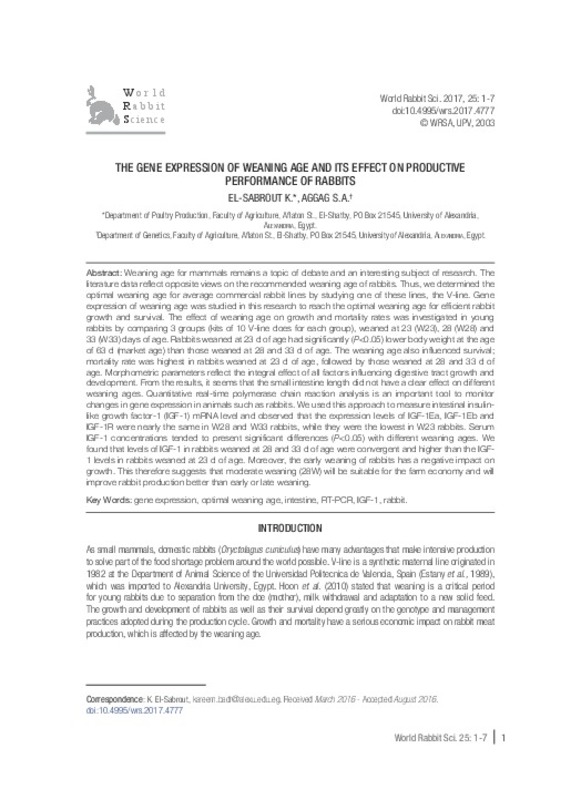JavaScript is disabled for your browser. Some features of this site may not work without it.
Buscar en RiuNet
Listar
Mi cuenta
Estadísticas
Ayuda RiuNet
Admin. UPV
The gene expression of weaning age and its effect on productive performance of rabbits
Mostrar el registro sencillo del ítem
Ficheros en el ítem
| dc.contributor.author | El-Sabrout, K.
|
es_ES |
| dc.contributor.author | Aggag, S.A.
|
es_ES |
| dc.date.accessioned | 2017-04-03T10:46:48Z | |
| dc.date.available | 2017-04-03T10:46:48Z | |
| dc.date.issued | 2017-03-30 | |
| dc.identifier.issn | 1257-5011 | |
| dc.identifier.uri | http://hdl.handle.net/10251/79365 | |
| dc.description.abstract | [EN] Weaning age for mammals remains a topic of debate and an interesting subject of research. The literature data reflect opposite views on the recommended weaning age of rabbits. Thus, we determined the optimal weaning age for average commercial rabbit lines by studying one of these lines, the V-line. Gene expression of weaning age was studied in this research to reach the optimal weaning age for efficient rabbit growth and survival. The effect of weaning age on growth and mortality rates was investigated in young rabbits by comparing 3 groups (kits of 10 V-line does for each group), weaned at 23 (W23), 28 (W28) and 33 (W33) days of age. Rabbits weaned at 23 d of age had significantly (P<0.05) lower body weight at the age of 63 d (market age) than those weaned at 28 and 33 d of age. The weaning age also influenced survival; mortality rate was highest in rabbits weaned at 23 d of age, followed by those weaned at 28 and 33 d of age. Morphometric parameters reflect the integral effect of all factors influencing digestive tract growth and development. From the results, it seems that the small intestine length did not have a clear effect on different weaning ages. Quantitative real-time polymerase chain reaction analysis is an important tool to monitor changes in gene expression in animals such as rabbits. We used this approach to measure intestinal insulin-like growth factor-1 (IGF-1) mRNA level and observed that the expression levels of IGF-1Ea, IGF-1Eb and IGF-1R were nearly the same in W28 and W33 rabbits, while they were the lowest in W23 rabbits. Serum IGF-1 concentrations tended to present significant differences (P<0.05) with different weaning ages. We found that levels of IGF-1 in rabbits weaned at 28 and 33 d of age were convergent and higher than the IGF-1 levels in rabbits weaned at 23 d of age. Moreover, the early weaning of rabbits has a negative impact on growth. This therefore suggests that moderate weaning (28W) will be suitable for the farm economy and will improve rabbit production better than early or late weaning. | es_ES |
| dc.language | Inglés | es_ES |
| dc.publisher | Universitat Politècnica de València | |
| dc.relation.ispartof | World Rabbit Science | |
| dc.rights | Reserva de todos los derechos | es_ES |
| dc.subject | Gene expression | es_ES |
| dc.subject | Optimal weaning age | es_ES |
| dc.subject | Intestine | es_ES |
| dc.subject | RT-PCR | es_ES |
| dc.subject | IGF-1 | es_ES |
| dc.subject | Rabbit | es_ES |
| dc.title | The gene expression of weaning age and its effect on productive performance of rabbits | es_ES |
| dc.type | Artículo | es_ES |
| dc.date.updated | 2017-04-03T09:52:34Z | |
| dc.identifier.doi | 10.4995/wrs.2017.4777 | |
| dc.rights.accessRights | Abierto | es_ES |
| dc.description.bibliographicCitation | El-Sabrout, K.; Aggag, S. (2017). The gene expression of weaning age and its effect on productive performance of rabbits. World Rabbit Science. 25(1):1-7. https://doi.org/10.4995/wrs.2017.4777 | es_ES |
| dc.description.accrualMethod | SWORD | es_ES |
| dc.relation.publisherversion | https://doi.org/10.4995/wrs.2017.4777 | es_ES |
| dc.description.upvformatpinicio | 1 | es_ES |
| dc.description.upvformatpfin | 7 | es_ES |
| dc.type.version | info:eu-repo/semantics/publishedVersion | es_ES |
| dc.description.volume | 25 | |
| dc.description.issue | 1 | |
| dc.identifier.eissn | 1989-8886 |








